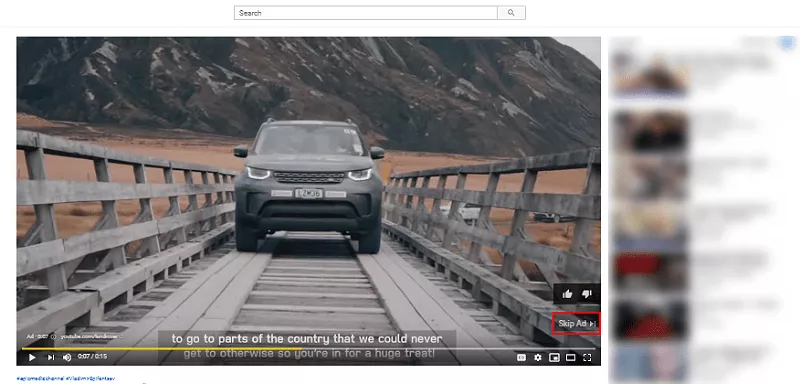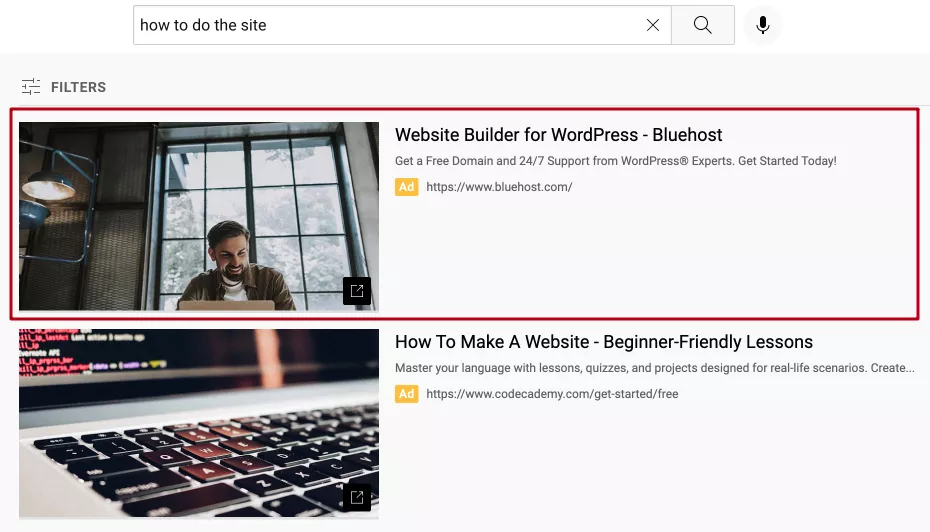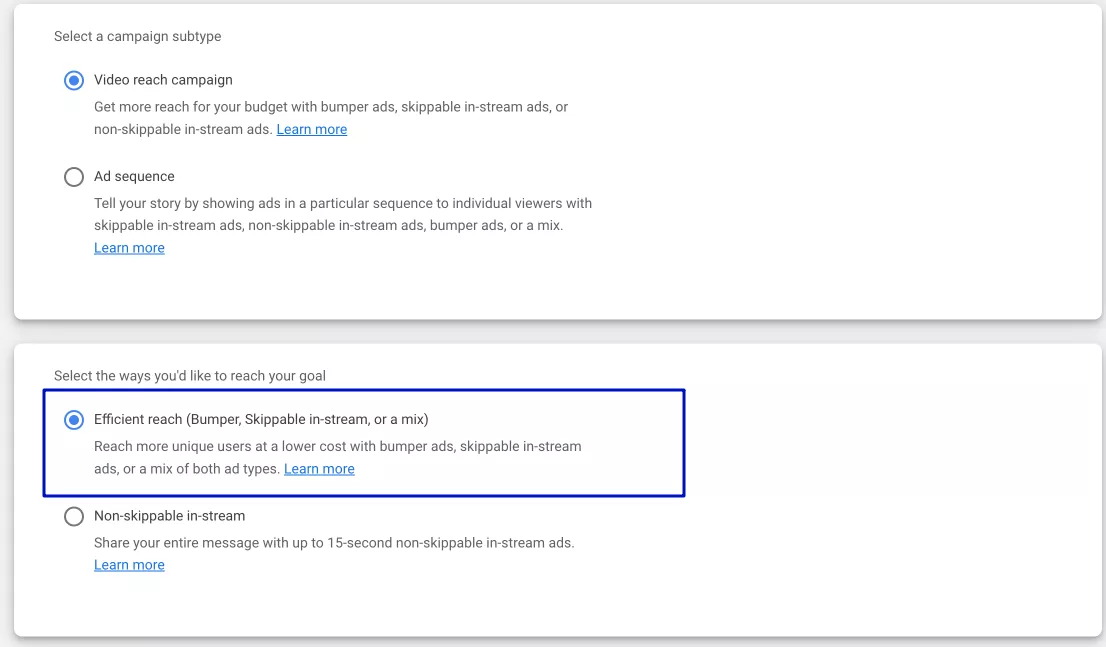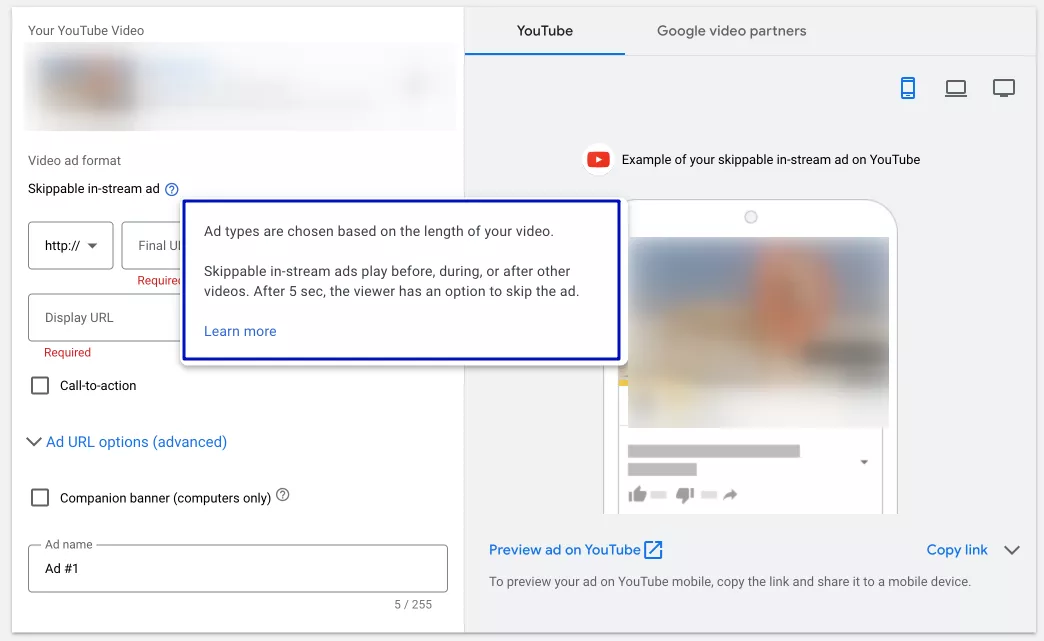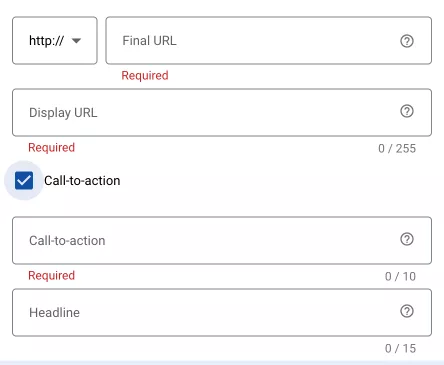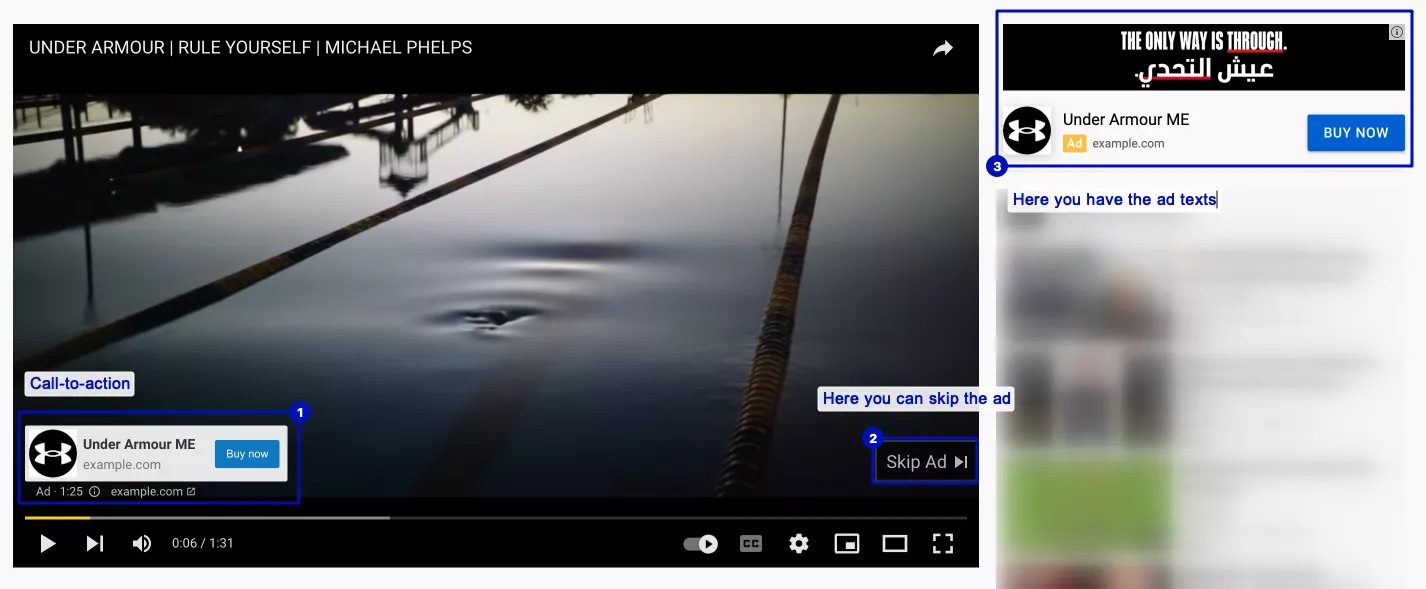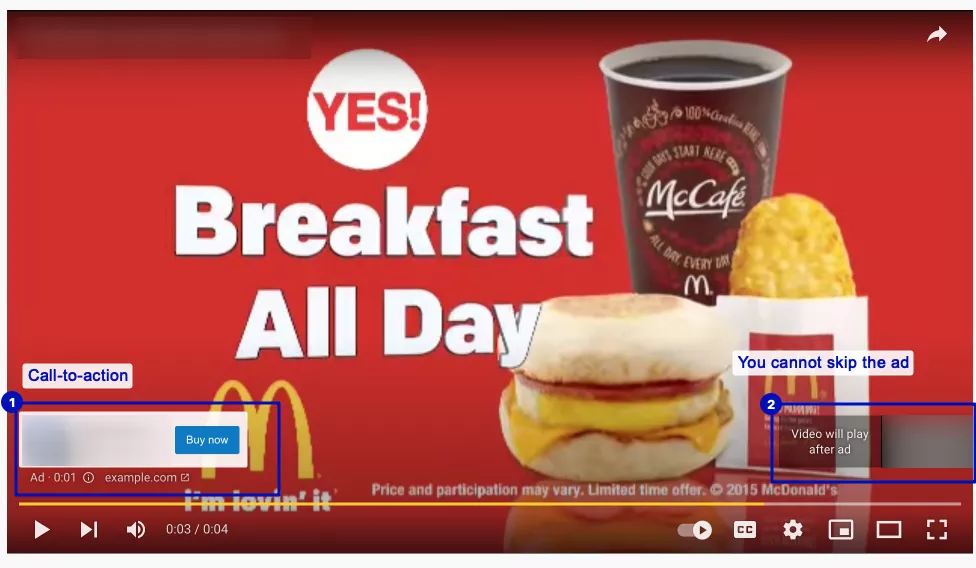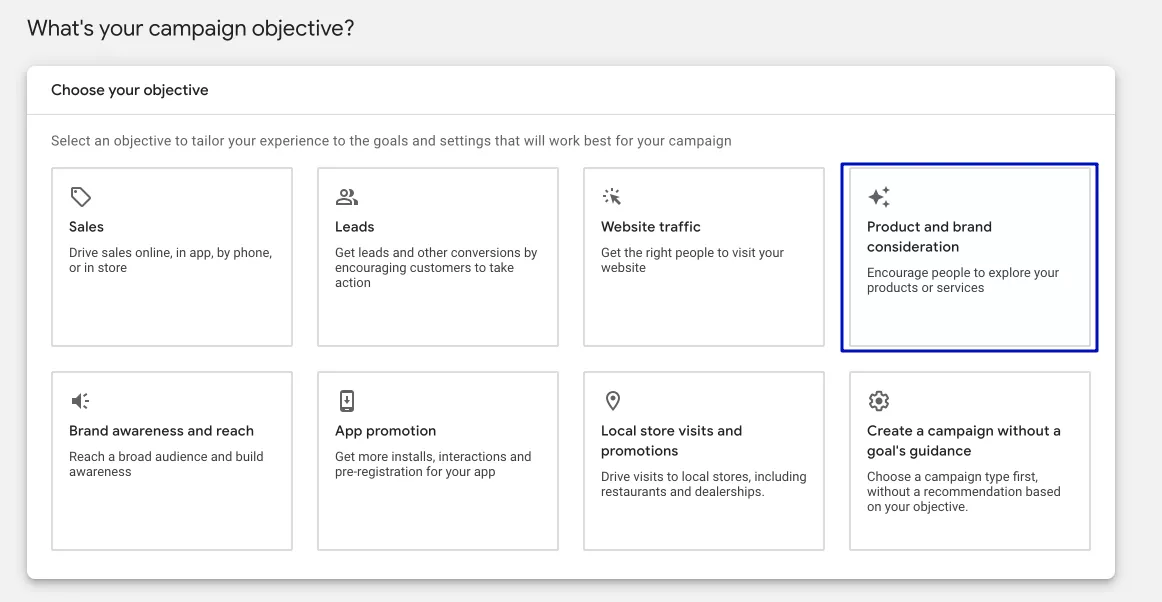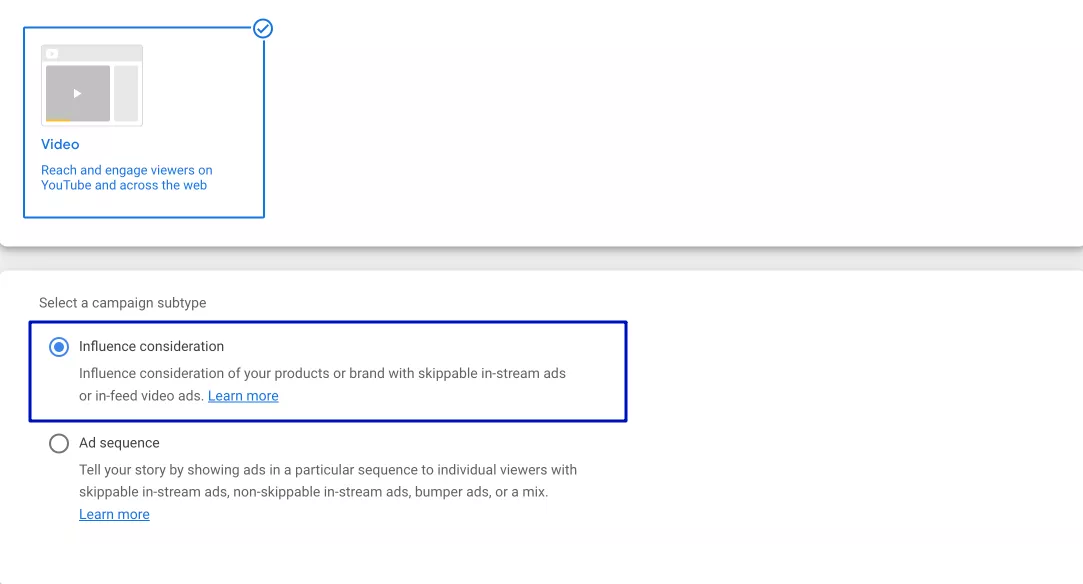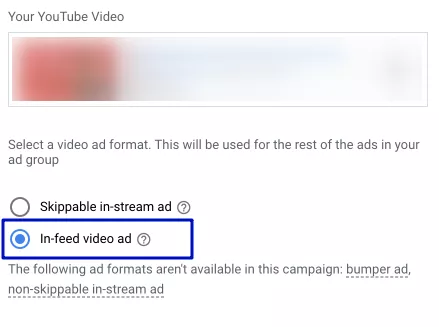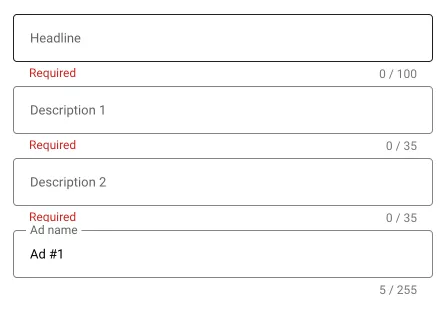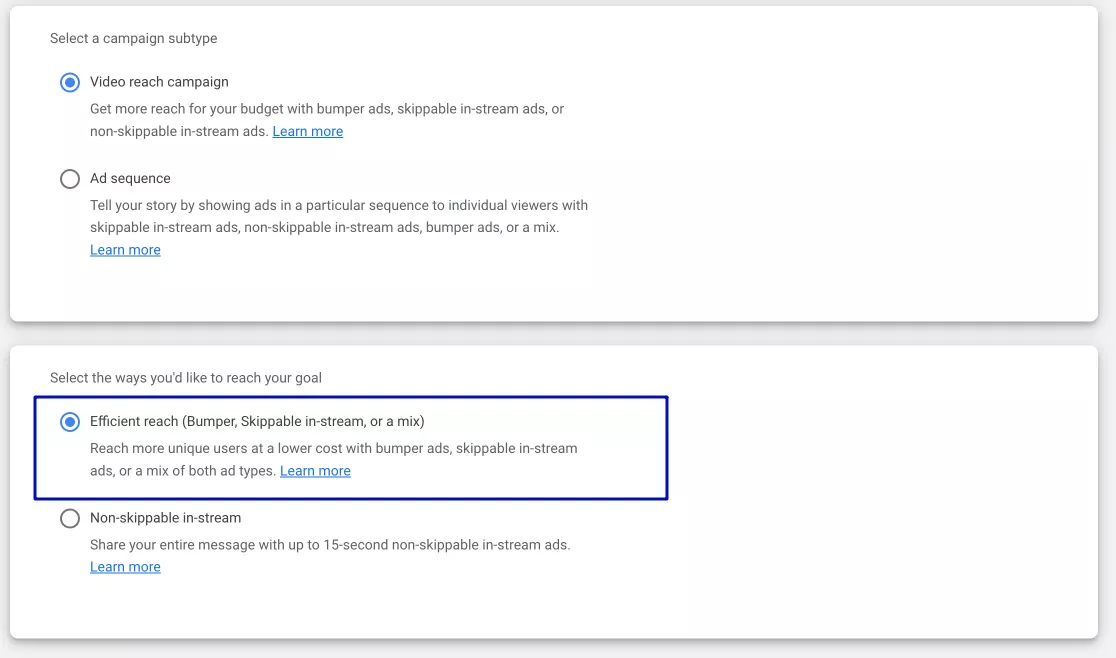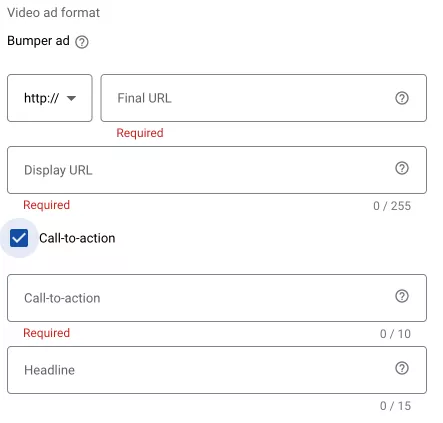Depending on your business goals, it is crucial to choose an appropriate ad campaign type and ad format. Careful selection of ad format will go a long way in helping your business achieve significant ROMI.
In this article, we will take a look at the basic types of video advertising on YouTube and Google media network: TrueView in-stream ads, in-feed ads, out-stream ads, and bumper ads.
Let's start with a quick overview of each ad type.
Table of Contents:
1. Overview
1.1. TrueView in-stream
1.2. In-feed video ads
1.3. Bumper ads
1.4. Outstream video ads
2. Why is Ad Format So Important?
3. TrueView In-Stream Ads
3.1. Skippable TrueView in-stream
3.2. Non-skippable TrueView in-stream
4. In-feed Video Ads
5. Outstream Video Ads
6. Bumper Ads
7. Conclusions
TrueView in-stream
TrueView in-stream commercials can be placed at the beginning, middle, or end of a video. After 5 seconds, the commercial can be skipped, or you can run the ad without the option of skipping. Skippable vs. non-skippable ads are discussed in detail below.
In-feed video ads
Classic in-feed ads (previously known as Discovery) include product reviews, comparison reviews, and tutorials. These videos are much longer in duration than in-stream ads, and range from 3 minutes to an hour. When a user enters a specific question in the search bar, they receive the answer to their query, even if it is hidden in the video.
In-feed video ads are displayed in:
- YouTube search pages;
- youtube.com video viewing pages;
- the main page of YouTube on mobile;
- mobile search pages.
Here is an example of in-feed advertising:
Bumper ads
Bumper ads are short commercials of up to 6 seconds that cannot be skipped. They can appear at the beginning, middle, or end of the video. When you develop short video ads, keep it brief and concise, and don't forget to include the unique selling points of your business.
Outstream video ads
These are special ads that only appear on mobile devices on the display network. For the advertiser to pay for display in the visible screen area, at least 50% of the commercial needs to be displayed on screen for at least two seconds.
Why Is Ad Format So Important?
The choice of ad format directly affects the type of advertising campaign. So, it determines the available bidding strategies, placements, additional options in the ad, etc.
Now, let's take a look at video campaign formats in more detail.
TrueView In-Stream Ads
TrueView in-stream ads appear on YouTube, sites/apps, and the display network.
There are several formats with and without the option to skip ads. In skippable TrueView in-stream, the user can watch the video until the end, visit the website, or skip the ad. The advertising fee is charged only if the viewer watches the video for at least 30 seconds or in its entirety. Therefore, the advertiser only pays for the attention of interested viewers.
There are two ways to use in-stream videos in campaigns:
- Skippable TrueView in-stream
- Non-skippable TrueView in-stream
To create a campaign, first select the objective “Brand awareness and reach” in the Google Ads interface. Next, choose the campaign type “Video” and the campaign subtype “Video reach campaign”. You then have a choice of “Efficient reach” or “Non-skippable in-stream".
Let's take a closer look into video campaign subtype “Influence consideration”.
Skippable TrueView in-stream

This is a classic advertising campaign type that allows you to pay only for interested viewers.
The available bidding strategies include CPM or cost-per-thousand impressions.
Video ads within the framework of this campaign will be displayed in YouTube videos and Google media network. If needed, this placement can be turned off.
When you create an ad, you must specify the final and displayed URL. Be sure to add a call-to-action and a title to create an eye-catching advertisement.
In-Stream ad components:
Non-skippable TrueView in-stream
This is another video campaign type with In-Stream ads, but with one big difference — the user cannot skip the video after 5 seconds. For this campaign, the recommended video length is up to 15 seconds. The available bid strategy is target CPM.
Visually, it differs from skippable in-stream video by the absence of a “Skip” button. Instead, a warning message appears: “The video will start after the advertisement" or “Video will play after the ad”.
The main advantage of this campaign is the ability to convey the necessary information to the audience in 15 seconds.The format also allows for maximum audience coverage.
In-feed Video Ads
Discovery ads are now known as in-feed video ads. To create this type of video ad, choose the objective “Product and brand consideration” and campaign subtype “Influence Consideration”.
When creating the ad, select “In-feed video ad”.
In-feed ads appear both in YouTube videos and in YouTube search results. This is an analogue of a search campaign specifically for YouTube. The user enters a search query in the search bar and sees advertising videos.
Campaigns that qualify for in-feed video ads now show commercials on both YouTube networks, allowing advertisers to reach more potential customers.
The format has one main advantage over ordinary in-stream ads. By showing video on demand, you will attract users who are especially interested in a product or brand. It allows you to increase brand loyalty and maintain contact with the audience.
To create a campaign, in the Google Ads interface, select the objective “Product and brand consideration” or “Create a campaign without objective prompts”. Set bidding strategy to “Maximum cost per view”.
You are charged only if the user clicks on the video icon to view the ad.
When you create an ad, you must provide a title, two descriptions, and a final URL.
Outstream Video Ads
Outstream ads are used to extend the reach of commercials and attract more customers on mobile devices. As these videos are played without sound, the viewer needs to click on the ad to listen and watch. Outstream ads are shown only on mobile devices and in Google partner apps.
It is important keep in mind that outstream ads are not available on YouTube. You are charged per thousand viewable ad impressions (vCPM). Therefore, you only pay when the viewer watches your video for at least 2 seconds.
Bumper Ads
This format involves videos that are shorter than 6 seconds. Fees are charged per thousand impressions. Unlike skippable in-stream ads, bumper ads cannot be skipped.
To create a video campaign with bumper ads, select the goal “Brand awareness and reach” or “Create a campaign without a goal's guidance”, and in the caption “Video” choose the way to achieve the goal “Efficient reach”.
Short promotional messages are a great way to reach your target audience. They can be used for new product announcements or to remind users about the brand/products with remarketing campaigns. For bid strategy, target CPM is available.
Important note: Usually, 1,000 bumper ad video impressions are cheaper than 1,000 In-Stream ad impressions.
Commercials can be displayed on YouTube videos and/or media networks. Keep in mind that you have the option to exclude partners.
When creating an ad, you must specify the final URL and add a call-to-action. There is also the option of adding a title and banner that will be used only for display on computers.
Bumper ads have one clear advantage — the user cannot skip the video ad. Despite the 6-second limit, the advertiser is able to send a clear message to the audience. Therefore, it is worth investing time and effort into creating a compelling video — use bright images, and be concise and clear.
These days, users are so tired of 30- or even 15-second commercials that they simply press the skip button and rarely consider the information conveyed in long commercials. Therefore, take advantage of short bumper ads as these do not test the patience of the audience.
Here is an excellent example of a bumper ad: the Road Lodge advertising campaign. In just 6 seconds, they are able to show that hotels are better for relaxation than for parties. The Road Lodge company made the advertisement concise and appealing.
An interesting hack for Bumper Ads is to make a how-to video and demonstrate problem-solving step by step.
An compelling example of a how-to bumper ad is shown in the KELLOGG'S commercial:
Read our article A Step-by-Step Guide to Creating a Demand Gen Campaign to learn more about advertising campaigns.
Conclusions
Advertising has changed significantly over the past few years — this article describes only a small part of these changes. Not only do video campaigns increase reach and brand recognition, but they also encourage users to perform targeted actions.
To conclude, here is a brief summary of the 4 different video ad types covered in this article.
- Skippable TrueView in-stream: A skippable video campaign where the advertiser pays for views by interested users. A convenient format for branding and building loyalty, the duration of the video is up to 30 seconds.
- Non-skippable TrueView in-stream. The video contains a warning that the video will start after an ad. The main advantage of this campaign is that it conveys the necessary information to the audience in 15 seconds. The format allows for maximum audience coverage.
- TrueView bumper ads: Unskippable video campaigns with bumper ads of duration up to 6 seconds and payment per thousand impressions. Bumper ad campaigns can be used to increase brand audience coverage, announce new products, or remind users about the brand and products with remarketing campaigns.
- In-feed video ads are an analogue of a YouTube search campaign. The user enters a search query and sees advertising videos that correspond to this query. The format allows you to form brand loyalty and maintain contact with the audience.
Related Articles
Display Advertising Effectiveness Analysis: A Comprehensive Approach to Measuring Its Impact
In this article, I will explain why you shouldn’t underestimate display advertising and how to analyze its impact using Google Analytics 4
Generative Engine Optimization: What Businesses Get From Ranking in SearchGPT
Companies that master SearchGPT SEO and generative engine optimization will capture high-intent traffic from users seeking direct, authoritative answers
From Generic to Iconic: 100 Statistics on Amazon Marketing for Fashion Brands
While traditional fashion retailers were still figuring out e-commerce, one company quietly revolutionized how U.S. consumers shop for everything from workout gear to wedding dresses

